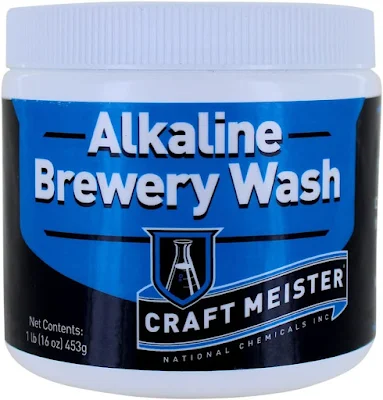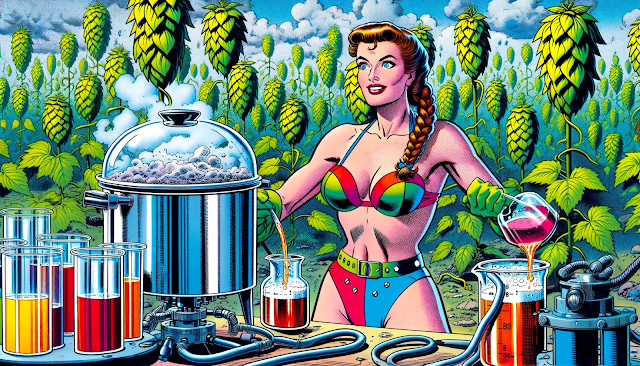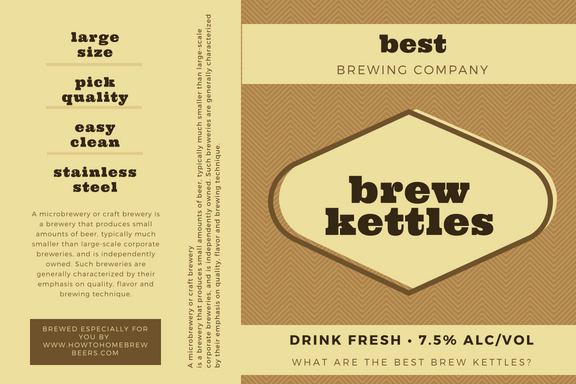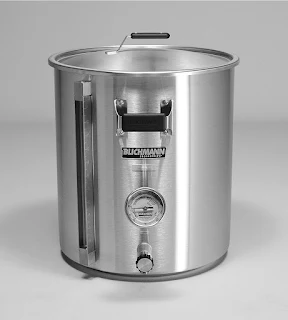🍺 Welcome to your go-to guide for troubleshooting the most common (and stressful) homebrewing problems.
Every brewer, from the novice to the seasoned expert, has faced a moment of panic: an airlock that won't bubble, a strange smell, or a final beer that just tastes... off.
Before you even think about dumping that batch, take a deep breath.
Most issues are fixable or, at the very least, preventable next time.
This guide is designed like a first-aid kit. For each issue, we provide a simple CARD that explains the problem, the science behind it, how to diagnose it, and most importantly, how to fix it.
Fermentation Worries 🌡️
My Airlock Isn't Bubbling
😱 The Problem:
You’ve pitched your yeast and sealed your fermenter, eagerly awaiting the tell-tale bubbling that signals fermentation has begun. But after 24-48 hours of watching, there is complete silence and no signs of activity in the airlock, leading you to question if anything is happening at all.
🤯 The Panic:
Is my yeast dead? Did I waste the whole batch?
🔬 The Science (What's Happening?):
Yeast consumes sugar (maltose) to produce ethanol and carbon dioxide (CO₂). This CO₂ gas builds pressure inside the fermenter and escapes through the path of least resistance - usually the airlock, causing bubbles. A lack of bubbles doesn't always mean a lack of fermentation; it often just means the CO₂ has found an easier way out.
🩺 Diagnose It:
- Check the Seal: Is the lid on tight? Is the grommet around the airlock secure? The most common culprit is a leaky seal. Gently press on the lid; if you see the airlock liquid move, your seal is likely good. If not, you have a leak.
- Check for Krausen: Shine a flashlight into your fermenter (if possible). A thick, foamy layer of yeast and protein (krausen) on top of the beer is a definitive sign of active fermentation.
- Take a Gravity Reading: This is the ultimate test. Use a sanitized wine thief and hydrometer. If your specific gravity has dropped from your Original Gravity (OG) reading, fermentation is happening, period.
✅ The Fix:
- If you have a leak: Find the source and seal it. Re-seat the lid or use keg lube on the O-ring. A little leak won't harm your beer at this stage, as the positive CO₂ pressure pushes contaminants out.
- If the temperature is too low: Move your fermenter to a warmer spot, within the ideal range for your yeast strain (typically 18-22°C for ales).
- If there are ZERO signs of fermentation after 72 hours: (no krausen, no gravity drop): Your yeast may be unviable. It's time to re-pitch with a fresh packet of yeast.
🛡️ Prevention:
Before pitching, always double-check that your fermenter lid and all seals are airtight. For liquid yeast or saved yeast, always make a starter to ensure a healthy cell count.
My Fermentation is Stuck
😱 The Problem:
Your fermentation started vigorously with plenty of airlock activity, but it has suddenly stopped well before you expected it to. Your hydrometer reading confirms the halt, showing that the gravity is stalled much higher than the recipe's target Final Gravity (FG).
🤯 The Panic:
My beer is going to be weak and sickeningly sweet. I'll have to throw it all out.
🔬 The Science (What's Happening?):
A stuck fermentation occurs when yeast flocculates (drops out of suspension) or becomes dormant prematurely. This can be caused by poor yeast health, a drastic temperature drop shocking the yeast, or a lack of essential nutrients.
🩺 Diagnose It:
Take gravity readings with a hydrometer over 2-3 consecutive days. If the reading is identical each day and is still significantly higher than your target FG, your fermentation is officially stuck.
✅ The Fix:
- Rouse the Yeast: Gently swirl the fermenter to get the yeast back into suspension where it can access the remaining sugars. Be careful not to introduce oxygen.
- Increase the Temperature: Slowly raise the temperature by a few degrees (e.g., from 19°C to 21°C). This can often "wake up" sluggish yeast.
- Pitch More Yeast: If the above fails, make a vibrant starter with a neutral, hardy strain (like US-05 or champagne yeast) and pitch it at high krausen into the fermenter.
🛡️ Prevention:
Ensure you pitch enough healthy yeast from the start (make a starter!). Aerate your wort properly before pitching, and maintain a consistent fermentation temperature.

Taste, Smell & Appearance Problems 👃
My Homebrew Tastes Sour
😱 The Problem:
You've patiently waited for your beer to finish, but upon taking the first taste, your palate is hit with an unexpected and unpleasant sourness. Instead of the clean malt and hop flavors you worked for, the beer has a distinct, sharp, acidic tang, almost like vinegar or spoiled milk.
🤯 The Panic:
I've accidentally made kombucha! Is it safe to drink? Has it gone bad?
🔬 The Science (What's Happening?):
An unintentional sour taste is almost always a sign of a bacterial infection. Wild yeast or bacteria like Lactobacillus consume sugars and produce lactic or acetic acid. This is desirable in a deliberately brewed Sour Ale, but a disaster in an IPA.
🩺 Diagnose It:
The taste is the primary indicator. You might also see a film or "pellicle" on the surface of the beer, a ropey texture, or a persistent haze that won't clear.
✅ The Fix:
Unfortunately, a true infection is irreversible. However, before you dump it, give it a taste. If the sourness is mild, you might have an accidental sour ale! CRUCIAL SAFETY NOTE: DO NOT BOTTLE an infected beer that is still sweet. The bacteria can create dangerous "bottle bombs."
🛡️ Prevention:
This is 100% about sanitation. Be absolutely meticulous about cleaning and sanitizing every single piece of equipment that touches your beer after the boil.
Is My Beer Infected? (Visual Signs)
😱 The Problem:
You look into your fermenter expecting to see a healthy, creamy layer of krausen, but instead, you notice something alien. There might be a chalky white film, weird web-like strands, or even fuzzy, colorful spots growing on the surface of your beer.
🤯 The Panic:
It's mould! My beer is ruined!
🔬 The Science (What's Happening?):
Different microbes create different visual signatures. Brewer's yeast (Saccharomyces) creates a thick, rocky, off-white to brown krausen. Contaminants create other things.
🩺 Diagnose It:
- Pellicle: A chalky white, wrinkly, or bubble-like film on the surface. This is a classic sign of wild yeast (Brettanomyces) or bacteria.
- Mould: Fuzzy, circular spots that are blue, green, or black. Mould is always bad.
- Ropey Strands: If your beer looks thick and viscous, almost like mucus, this is a sign of a Pediococcus infection.
✅ The Fix:
- Pellicle/Ropey Strands: The beer is infected. You cannot remove it. Decide if it's drinkable or needs to be dumped.
- Mould: If you see any fuzzy mould, the batch is a dumper. It is not safe to consume. The health risk is not worth it.
🛡️ Prevention:
Meticulous post-boil sanitation. Also, ensure minimal headspace in your fermenter to reduce the surface area exposed to oxygen, which some contaminants need.
Brew Day & Process Problems 🛠️
The Dreaded Boil-Over
😱 The Problem:
You're heating your wort to a boil when you turn your back for a second, only to hear a hiss. A massive column of foam has rapidly erupted over the sides of your kettle, covering your stovetop with hot, sticky wort and causing a major mess.
🤯 The Panic:
It's a sticky mess! Am I losing a lot of my precious wort?
🔬 The Science (What's Happening?):
When wort is heated, proteins from the malt coagulate and form a matrix. This matrix traps steam and CO₂ being released, creating a rapid and stable foam. This initial surge is called the "hot break."
🩺 Diagnose It:
It's happening right in front of you! The key is to catch it before it spills.
✅ The Fix:
- Reduce Heat: Immediately turn down the heat source.
- Stir: Vigorously stir the top layer of foam to break it up.
- Spray Bottle: A quick spray of cold water from a sanitized spray bottle will instantly kill the foam.
🛡️ Prevention:
- Kettle Size: Use a kettle that is at least 2x your batch size. Headspace is your best friend.
- Fermcap-S: A few drops of this food-grade, anti-foaming agent in the boil kettle will almost completely eliminate the risk.
- Watch the Pot: Never turn your back on your kettle as it approaches boiling temperature.
Decoding Off-Flavors
😱 The Problem:
Your beer is finally carbonated and chilled, but the flavor is dominated by an unexpected and out-of-place taste. It could be anything from buttered popcorn to wet cardboard or cooked vegetables, making the beer unpleasant to drink despite looking fine.
🤯 The Panic:
I followed the recipe perfectly! Why does my beer taste like butter/cardboard/cabbage?
🔬 The Science (What's Happening?):
Unwanted flavors are chemical compounds produced either by the yeast under stress, by spoilage organisms, or by chemical reactions like oxidation.
🩺 Diagnose It:
Use the chart below. Isolate the flavor and identify the likely cause.
Flavor / Aroma Tastes/Smells Like Cause & Solution Acetaldehyde Green Apples, Latex Paint Cause: Yeast was removed from beer too early. Fix: Let fermentation finish completely. Raise temp slightly for a diacetyl rest at the end. Diacetyl Movie Theatre Popcorn, Butterscotch Cause: Stressed yeast didn't reabsorb it. Fix: Maintain proper fermentation temp & allow a diacetyl rest (raise temp 2-3°C for 2 days at end). DMS (Dimethyl Sulfide) Cooked Corn, Canned Cabbage Cause: DMS precursor wasn't boiled off. Fix: Ensure a vigorous, rolling boil for 60+ mins with the lid partially off. Cool the wort rapidly. Oxidation Wet Cardboard, Stale Paper Cause: Oxygen introduced to finished beer. Fix: This is not reversible. Prevent by siphoning gently, minimizing splashing, and purging kegs with CO₂. Medicinal / Phenolic Cloves, Bandaids, Smoky Cause: Wild yeast, sanitizer residue, or yeast strain. Fix: Meticulous sanitation and proper rinsing. Use the correct yeast for the style.
🛡️ Prevention:
Pitch healthy yeast, control fermentation temperature, boil vigorously, and avoid splashing your finished beer.
My Finished Beer is Too Sweet
😱 The Problem:
You've bottled and carbonated your beer, but the final product is unbalanced and cloying. Instead of a satisfying finish, it tastes like unfermented wort or sugary soda, lacking the crispness or dryness you expected from the recipe.
🤯 The Panic:
This is undrinkable. Did I add too much sugar?
🔬 The Science (What's Happening?):
Sweetness comes from residual, unfermented sugars. This happens if 1) the yeast didn't finish its job (see Card 2), or 2) the wort was created with a high percentage of unfermentable sugars due to a high mash temperature.
🩺 Diagnose It:
Check your Final Gravity (FG). If it's much higher than predicted, you have a lot of residual sugar. A mash temp above 69°C (156°F) creates more unfermentable dextrins, leading to a sweeter, fuller-bodied beer.
✅ The Fix:
If the cause was a high mash temp, there's no way to fix it now. You can try to balance the sweetness by dry hopping with a large amount of resinous hops to increase bitterness and aroma.
🛡️ Prevention:
Control your mash temperature accurately. For a drier beer, mash lower (64-66°C). For a sweeter, fuller beer, mash higher (68-69°C).
I Missed My Target Gravity
😱 The Problem:
After finishing your mash or your boil, you take a hydrometer reading and find that your Original Gravity (OG) is significantly off from the recipe's target. This means the sugar concentration is wrong, which will directly impact the final alcohol content and body of your beer.
🤯 The Panic:
My beer is going to be way too strong/weak!
🔬 The Science (What's Happening?):
Gravity is a measure of dissolved sugars. Missing your target means you extracted more or less sugar from the grain than expected (efficiency), or your water volume is off.
🩺 Diagnose It:
Take a hydrometer reading after the mash (pre-boil) or after the chill (OG) and compare it to the recipe's target.
✅ The Fix:
- If Gravity is TOO LOW:
- Pre-Boil: Boil the wort for longer to evaporate more water, concentrating the sugar.
- Post-Boil: Add Dry Malt Extract (DME). Rule of thumb: 100g of DME raises the gravity of a 20L batch by ~0.002 points.
- If Gravity is TOO HIGH:
- Add clean, sanitized water to dilute the wort down to the target gravity. This will increase your final volume.
🛡️ Prevention:
Ensure your grain is crushed properly. Monitor your mash temperature and pH. Measure your water volumes precisely.
My Bottled Beer is Flat 🍾
😱 The Problem:
After weeks of patient conditioning, you chill and open your first bottle in anticipation, only to be met with a disappointing lack of sound and fizz. The beer pours with no head and has the thin, lifeless mouthfeel of flat soda, completely missing the carbonation that gives beer its character.
🤯 The Panic:
All that work for a flat, lifeless beer.
🔬 The Science (What's Happening?):
Bottle carbonation is a mini-fermentation. You add priming sugar before bottling. The remaining yeast consumes this sugar, producing CO₂. Trapped in the bottle, this CO₂ dissolves into the beer, creating carbonation.
🩺 Diagnose It:
The beer has no foam and a lack of fizzy mouthfeel.
✅ The Fix:
- Wait Longer: The most common issue is impatience. Store the bottles at a consistent room temperature (around 21°C) for at least 3 weeks.
- Move to a Warmer Spot: If the bottles are too cold, the yeast will be dormant. Move them somewhere warmer for a week.
- Gently Rouse: Gently invert the bottles once or twice (don't shake!) to get the yeast back into suspension.
🛡️ Prevention:
Make sure primary fermentation is truly finished before bottling. Use a priming sugar calculator to add the correct amount of sugar. Ensure your bottle caps have a perfect, airtight seal.
Conclusion 🍻
Brewing beer is a craft where you learn as much from your mistakes as your successes. Don't be discouraged by a boil-over or a flat bottle.
By understanding the science behind the process, you can learn to diagnose issues, correct your course, and ultimately, brew better beer every time. Keep this guide handy, stay calm, and happy brewing!












